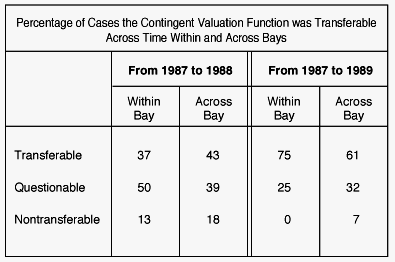


This table shows the results of a study testing the reliability of the
benefit function transfer approach.

What are the conditions under which the transfer of recreational benefits may be tenable? Considering the information that exists about nonmarket resource valuation, is the issue of benefits transfer a viable topic? How can statistically sound methods be established by which feasibility may be determined?

This research presents an experiment designed to test the reliability of the benefit function transfer approach using contingent valuation methods. Benefit transfer in this case refers to the process by which a benefit estimated for a particular study site for which data exist is transferred to a policy site for which no data exist. At issue in the functions transfer approach is the presence of statistically similar contingent valuation functions that may yield similar welfare measures.
The procedure of utilizing the benefit function transfer approach to determine terms of appropriated compensation to harmed individuals at a policy site is unreliable. This is so because many of the benefit functions that were transferable did not yield statistically familiar benefit estimates. Thus, benefits that are transferred from a study site to a policy site using the benefit function transfer approach could be misleading or inaccurate.
The overall conclusion, at least for the data at hand, is that the benefit function transfer approach is not a reliable approach for the transfer of benefits. It is suspected that the nonlinearity of the logic model used to estimate the benefit functions and the nonlinearity of the benefits estimates themselves greatly contribute to this result. The nonlinearities introduce possible asymmetries, which lead to the divergence between statistically similar benefit functions and their respective benefit estimates.

Downing, M. and T. Ozuna, Jr. 1992. Testing the feasibility of intertemporal benefits transfer within and across geographic regions. TA-30619. Texas Agricultural Experiment Station, College Station, Tex.
Downing, M. and T. Ozuna, Jr. 1992. Testing the feasibility of intergeographic benefit function transferability. TA-30660. Texas Agricultural Experiment Station, College Station, Tex.
Integrated Assessment Briefs. 1995. ORNL/M-4227. Oak Ridge National Laboratory, Oak Ridge, TN.